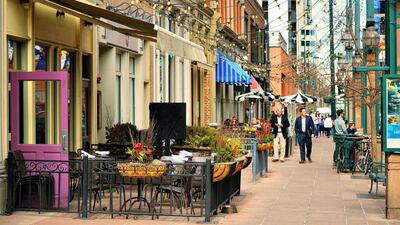An urban exodus by Americans looking for more spacious and affordable homes during the Covid-19 pandemic has caused rents to plummet in some of the biggest cities in the US, according to a new property report.
Rents for one-bedroom apartments in San Francisco are dropping at the fastest rate in the country after prices fell 45 per cent in March compared with the same period a year ago, Apartment Guide's April 2021 Rent Report found.
The exodus has been led by tech employees in San Francisco, which is home to Silicon Valley tech giants such as Apple, Alphabet and Facebook, whose employees are working remotely either indefinitely or permanently. It's also one of the most expensive cities in the US to live.
Other cities that experienced the fastest falls in one-bedroom rents year-on-year include Chesapeake in Virginia (29.4 per cent), New York City (27.3 per cent), Long Beach, California (27 per cent), and Colorado Springs, Denver (24.6 per cent), the report, which analysed one- and two-bedroom apartment rents in the 100 most populated cities in the US, found.
Despite recording significant annual rent declines, five cities – San Francisco, New York, Los Angeles (rent dip of 16 per cent), Jersey City (15.5 per cent) and San Jose (16.2 per cent) – were among the 10 most expensive rental markets for two-bedroom apartments, it added.
Austin, Texas, which serves as a major base for companies like Dell, Whole Foods, SolarWinds and Oracle, had the most new arrivals between April 2020 and October 2020, while Hartford, Connecticut, New York City and San Francisco's Bay Area lost the most residents, according to LinkedIn's December Workforce Report, which tracks migration trends across the US,
Meanwhile, incomes fell for about half of all US tenants during the Covid-19 pandemic, an April report by Harvard's Joint Centre for Housing Studies found. The study estimated that income losses were worse for renter households headed by people of colour or younger people, and those with lower incomes.
"The study suggests that this trend continues into 2021, so we will continue to keep an eye out for rental trends we’ve seen so far in the pandemic – most notably, a trend towards household consolidation, which mirrors what was seen in the Great Recession of 2008," the report said.
Studios and one-bedroom apartments are showing some recovery in rental prices, indicating growing demand, the Apartment Guide report said.
“Two-bedrooms have adjusted down slightly, but are still up more than five per cent year-over-year. Three-bedrooms are up, both since last month and since this time last year.”
The average rent for a studio apartment in the US costs about $1,603 a month, the report said. A one-bedroom apartment is $1,610, a two bedroom $1,881 and a three bedroom $2,036, it added.
Meanwhile, the US cities that experienced the biggest annual increases in one-bedroom rents were Kansas City (33.5 per cent), Missouri (33.5 per cent), Gilbert, Arizona (26 per cent), Las Vegas (25.3 per cent), Riverside, California (24.9 per cent), and Buffalo, New York (23.3 per cent). However, none of these cities made it into the 10 most expensive rental markets for one-bedroom apartments, the report said.
Two-bedroom apartment rents that recorded the biggest declines were in Long Beach, California, at 31 per cent, followed by Seattle (30.6 per cent), Chesapeake (25.2 per cent), St. Petersburg, Florida (24.5 per cent) and San Francisco (24 per cent), according to Apartment Guide.
Despite seeing a considerable decline in rents annually, San Francisco and Oakland, California, ranked among the 10 most expensive markets for one-bedroom apartments by rent prices, the report said.
US cities where two-bedroom apartment rents increased the most year-on-year were Riverside (56 per cent), North Las Vegas (39.9 per cent), Buffalo (38.6 per cent), Detroit (32.5 per cent) and Las Vegas (31.1 per cent), it added.









